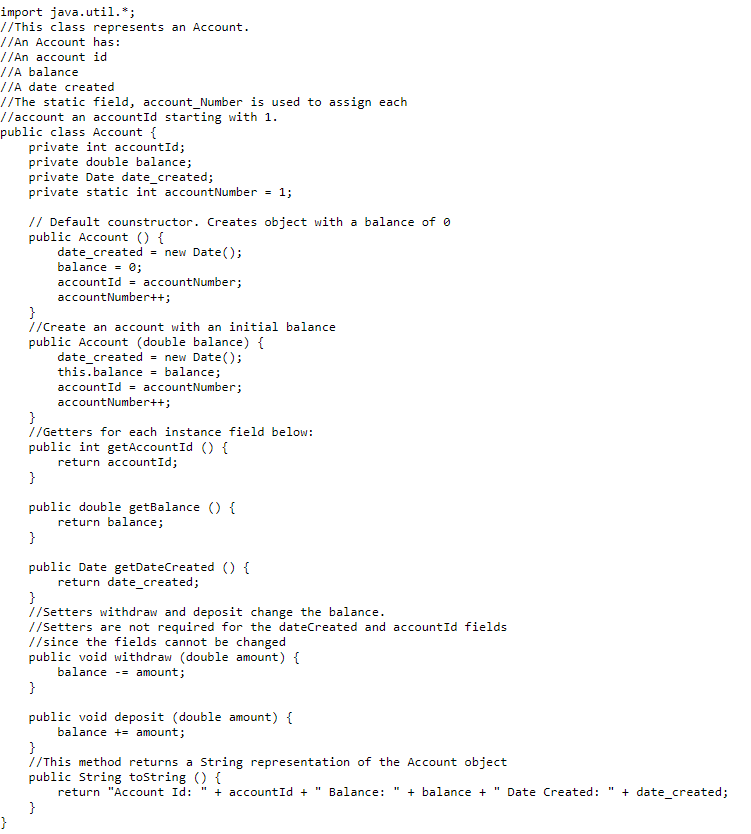import java.util.* //This class represents an Account. / /An Account has: //An account id //A balance //A date created //The static field, account Number is used to assign each //account an accountId starting with 1. public class Account private int accountId; private double balance private Date date_created private static int accountNumber = 1: 1Default counstructor. Creates object with a balance of 0 public Account ) date_created = new Date(); balance= 0; accountId = accountNumber; accountNumber++ } /Create an account with an initial balance public Account (double balance) date_created = new Date () this.balance balance; accountNumber; accountId = accountNumbert+; //Getters for each instance field below public int getAccountId () return account Id; public double getBalance ) return balance; } public Date getDateCreated ) return date_created; //Setters withdraw and deposit change the balance //Setters are not required for the dateCreated and accountId fields //since the fields cannot be changed public void withdraw (double amount) balance -= amount; } public void deposit (double amount) balance amount; } //This method returns a String representation of the Account object public String toString () { return "Account Id: Balance: balance + Date Created: date_created accountId } }
Use the Java Class, Account.java, provided. Please do not rename or make any changes to this class. Do not turn in the Account class. Your
Write a Java Program that meets the following requirements:
1. Write a Java class, rinoel_Bank.
2. At the beginning of the program include a comment with your name and a brief description of the program. Please include a short comment befor each method
3. The Bank class will have the following instance variables:
a. An Array of Account objects that can hold 20 Accounts named, bank.
b. An int variable, numberOfAccounts which indicates the number of Account objects in the account array
4. The Bank class will have the following constructor:
a. A default/noargs constructor:
i. It will create the Array of Account objects
ii. Set the numberOfAccounts to zero
b. One accessor method:
public int getNumberOfAccounts() //returns the numberOfAccounts
c. The following methods:
public void addAccount (Account a)
Adds Account object, a, to the Array of accounts
Adds 1 to the numberOfAccounts
public void addAccount(double initBalance)
Creates a new Account using initBalance
Adds the new Account to the Array of accounts
Adds 1 to the numberOfAccounts
public double getTotalBalance()
Returns the sum of the balance of all the Account objects in the Array of
accounts
public Account getMaxBalance()
Returns the Account with the highest balance in the Array of accounts
d. A toString() method that returns a String representation of the Bank object in
the format shown in the sample output below.
public String toString()
5. Write a test program, rinoel_TestBank.java
which does the following:
a. Create a Bank object
b. In a loop, repeat 5 times:
i. Using a Scanner, prompt the user for the balance of an Account object.
ii. Call the addAccount method of the Bank to add an Account object to the
Array using the balance entered by the user. You can call either of the two addAccount methods of the Bank class.
c. At the end of the loop, print the Bank object.
d. Using the methods of the Bank class, print the following in the format shown
below:
i. The total balance of all accounts in the Bank using the
getTotalBalance() method of the Bank class
ii. The Account with the highest balance in the array of Accounts using the
getMaxBalance() method of the Bank class.
e. The prompts and output should be formatted like the sample program running below.
f. Readability and indentation: Code should be easy to read and properly indented. Variable names should be descriptive
Sample Program running
Enter a balance
100
Enter a balance
200
Enter a balance
300
Enter a balance
400
Enter a balance
500
The accounts in the Bank are:
Account ID: 1 Balance: 100.0 Date Created Sun Mar 20 10:18:17 EDT 2016
Account ID: 2 Balance: 200.0 Date Created Sun Mar 20 10:18:18 EDT 2016
Account ID: 3 Balance: 300.0 Date Created Sun Mar 20 10:18:19 EDT 2016
Account ID: 4 Balance: 400.0 Date Created Sun Mar 20 10:18:20 EDT 2016
Account ID: 5 Balance: 500.0 Date Created Sun Mar 20 10:18:22 EDT 2016
The total balance in the bank is 1500.0
The account with the highest balance in the bank is
Account ID: 5 Balance: 500.0 Date Created Sun Mar 20 10:18:22 EDT 2016

Trending now
This is a popular solution!
Step by step
Solved in 7 steps with 4 images









